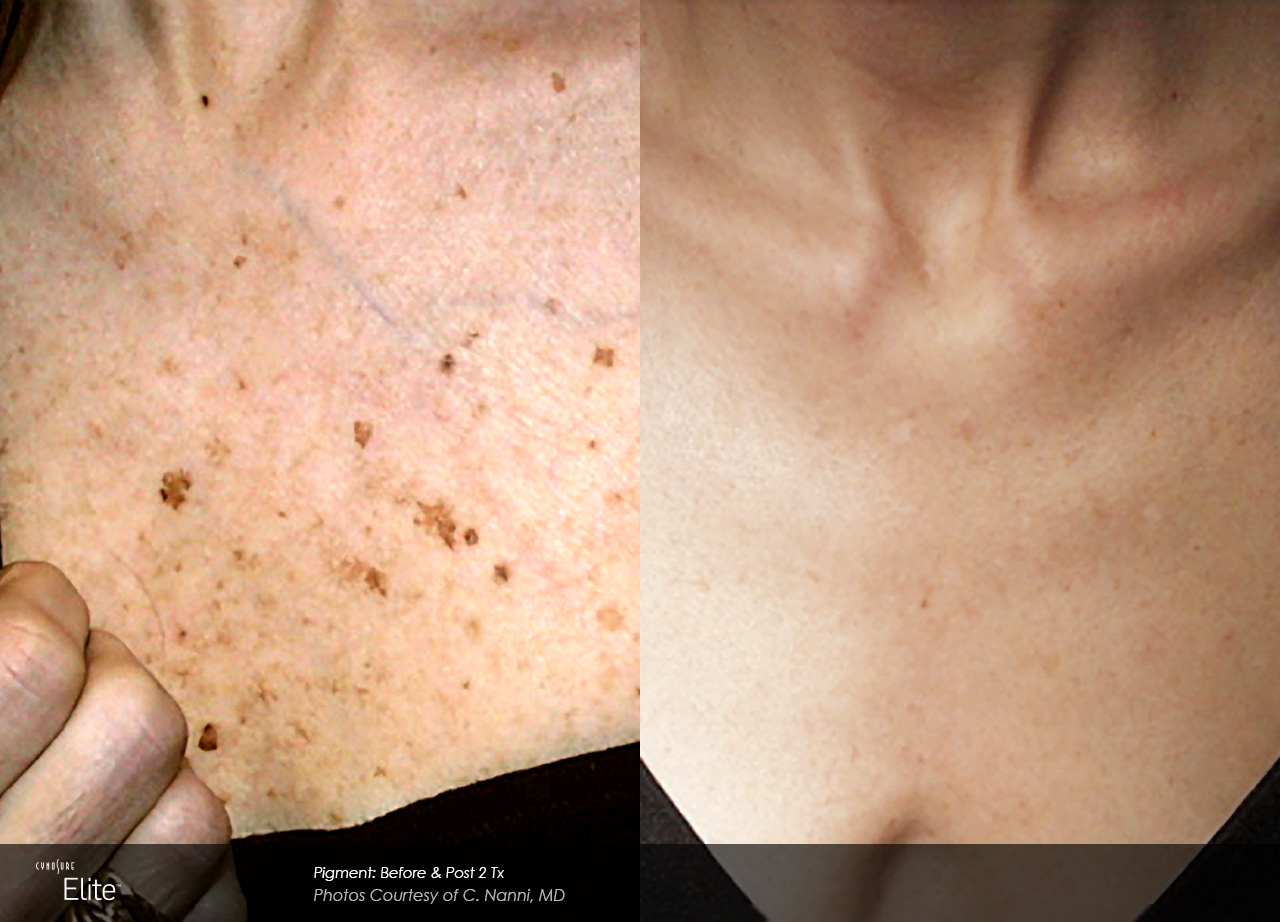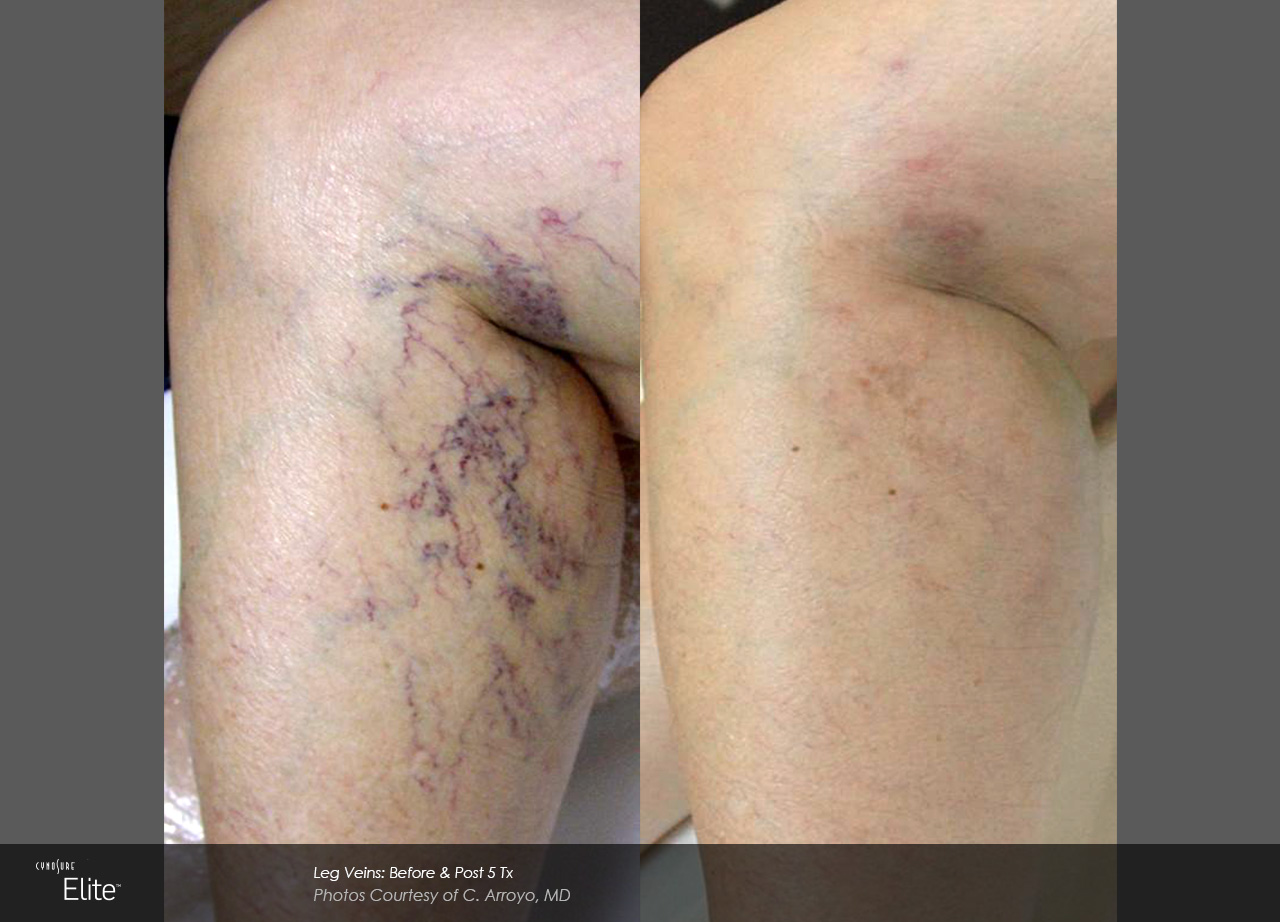treatment
Elite Apogee+
This completely customizable cosmetic laser system treats pigmented lesions, leg veins and facial veins.
The laser targets the melanin and hemoglobin causing them to slowly disappear through your body’s natural healing process, without harming the surrounding skin. Elite+ offers the flexibility to customize treatments to encompass all skin types and conditions.
How Elite Apogee+ Works
For treatment of Pigmented Lesions
Elite Apogee+ lasers deliver precise amounts of energy to effectively treat unwanted pigment and improve sun-damaged skin. The laser handpiece is placed over the skin where the brown spot or other pigmentation sits, and energy is released. This energy is absorbed by the melanin in sunspots and converted to heat. The heat damages the cells that created the pigment and causes your body to naturally dispose of this tissue while creating new, healthy tissue.
For treatment of Leg Veins or Vascular Lesions
The laser handpiece will deliver light energy into your skin and will be absorbed by the blood within the vein being targeted while leaving the surrounding skin unharmed. Once the blood absorbs this energy, the vein or lesion will heat up and it will affect the vessel lining, causing the vessel to constrict and eventually fade from view leaving your legs looking clear and as beautiful as ever.

benefits

Improves the appearance of microvasculature and pigmented lesions

Results may be seen after one treatment

Minimal to no downtime

Minimal to no discomfort
Elite Apogee+ Procedure
For treatment of Pigmented Lesions
The laser may feel like a moderate to severe pinprick or flash of heat. A mild sunburn-like sensation is expected. This usually lasts 2-24 hours but can persist for up to 72 hours. Mild swelling may accompany this, but it is usually resolved within 3 days. The redness/vessels may undergo immediate graying or blanching, or they may exhibit a slight purple or red color change. The vessels will fully or partially fade in about 10-14 days.
For treatment of Leg Veins
Before your leg vein treatment, the laser specialist will typically apply a gel to the area being treated. This will help ensure the laser energy is delivered appropriately and will help cool the area during and after the treatment. The provider will begin the treatment by moving the laser handpiece over your skin, following the length of the vein and pulsing the energy as they go. You will be provided safety goggles before the treatment to protect your eyes but you may still see flashes of light as the laser energy is being delivered to your skin. You will also feel a mild sensation and heat on the skin during the treatment but air cooling may be used to help with any discomfort.
The vessels may undergo immediate graying or blanching, or they may exhibit a slight purple or red color change. The vessels will fully or partially fade in about ten to fourteen days.



Frequently Asked Questions About Elite Apogee+ for pigmented legions
What does it feel like?
Treatments are very well tolerated. Many clients describe the treatment as a ‘warm sensation’ or the snap of a rubber band.
What do I need to do before a treatment?
You will need to avoid the sun, tanning beds and self-tanning creams and lotions prior to treatment. There may be some medications that you will need to avoid, we will cover these during your consultation.
How quickly will I recover?
Typically, you can resume regular daily activities immediately following treatment. Makeup can be applied to the treated area immediately, if necessary.
It is extremely important to apply a moisturizer with SPF30 sunblock and avoid sun exposure on a daily basis to prevent additional sun damage.
Am I a candidate?
Our laser specialists can give you a consultation and talk with you about your skin type to confirm if you would be a good candidate for this treatment.
How long will it take?
The procedure typically takes less than 30 minutes to perform depending on the size of the area being treated. Often you will see great results after the first treatment session, but 2-3 sessions may be required for optimal outcomes.
What will happen after the procedure?
Some patients experience a mild sunburn sensation for a short time after the procedure. We may apply some ice immediately following your treatment to help minimize this.
The pigmented lesions will darken over the next few days. The area will look a bit “dirty” or dark for about a week. Over this time, the treated skin will slough off, revealing fresh new skin.
What areas can be treated?
Laser pigment clearance can be performed on the face and body, including the hands, arms and legs.
How many treatments will I need?
This will often depend on the pigmented lesion you have. For some brown spots, only a single treatment is needed, for others, a series of treatments may be recommended. Often you will see improvements within a couple weeks, with further improvements on subsequent treatments until you have achieved the overall improvement you desire.
Frequently Asked Questions About Elite Apogee+ for Leg Veins
What types of veins can be treated?
It is ideal for spider veins and reticular veins on your legs.
What type of result can I expect?
Many patients experience immediate improvement in the appearance of their leg veins with continued improvement over the course of the next 90 days.
What does the procedure feel like?
Patients describe a range of sensations from tingling to the snap of a rubber band during the procedure. You may also feel warmth during and after the procedure on the area that was treated.
How long does the treatment take?
Depending on the size of the area being treated, they can take just minutes. Typically, treatments are no longer than 60 minutes.
How many treatments will I need?
A series of treatments may be needed to fully clear blood vessels and reduce the appearance of the leg veins completely. Typically, one to four sessions are needed for desired results.
When can I resume my daily activities?
Typically, there is minimal downtime and you can resume your normal activities within a few days after treatment. Significant bruising may occur in some patients.
